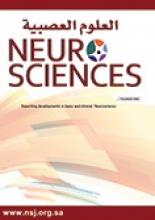Brief ReportBrief Communication
Open Access
Novel compound heterozygous mutations in MCPH1 gene causes primary microcephaly in Saudi family
Muhammad I. Naseer, Mahmood Rasool, Angham A. Abdulkareem, Randa I. Bassiouni, Hussein Algahtani, Adeel G. Chaudhary and Mohammad H. Al-Qahtani
Neurosciences Journal October 2018, 23 (4) 346-350; DOI: https://doi.org/10.17712/nsj.2018.4.20180095
Muhammad I. Naseer
From the Center of Excellence in Genomic Medicine Research (Naseer, Rasool Abdulkareem, Chaudhary, Al-Qahtan) King Abdulaziz University, and from King Abdulaziz Medical City (Algahtani), King Saud bin Abdulaziz University for Health Sciences, Jeddah, Kingdom of Saudi Arabia, and from Clinical Genetic Division of Human Genetics & Genome Research, National Research Center (Bassiouni), Dokki, Giza, Egypt
M.phil, PhDMahmood Rasool
From the Center of Excellence in Genomic Medicine Research (Naseer, Rasool Abdulkareem, Chaudhary, Al-Qahtan) King Abdulaziz University, and from King Abdulaziz Medical City (Algahtani), King Saud bin Abdulaziz University for Health Sciences, Jeddah, Kingdom of Saudi Arabia, and from Clinical Genetic Division of Human Genetics & Genome Research, National Research Center (Bassiouni), Dokki, Giza, Egypt
PhDAngham A. Abdulkareem
From the Center of Excellence in Genomic Medicine Research (Naseer, Rasool Abdulkareem, Chaudhary, Al-Qahtan) King Abdulaziz University, and from King Abdulaziz Medical City (Algahtani), King Saud bin Abdulaziz University for Health Sciences, Jeddah, Kingdom of Saudi Arabia, and from Clinical Genetic Division of Human Genetics & Genome Research, National Research Center (Bassiouni), Dokki, Giza, Egypt
PhD studentRanda I. Bassiouni
From the Center of Excellence in Genomic Medicine Research (Naseer, Rasool Abdulkareem, Chaudhary, Al-Qahtan) King Abdulaziz University, and from King Abdulaziz Medical City (Algahtani), King Saud bin Abdulaziz University for Health Sciences, Jeddah, Kingdom of Saudi Arabia, and from Clinical Genetic Division of Human Genetics & Genome Research, National Research Center (Bassiouni), Dokki, Giza, Egypt
MDHussein Algahtani
From the Center of Excellence in Genomic Medicine Research (Naseer, Rasool Abdulkareem, Chaudhary, Al-Qahtan) King Abdulaziz University, and from King Abdulaziz Medical City (Algahtani), King Saud bin Abdulaziz University for Health Sciences, Jeddah, Kingdom of Saudi Arabia, and from Clinical Genetic Division of Human Genetics & Genome Research, National Research Center (Bassiouni), Dokki, Giza, Egypt
MD, FRCPSAdeel G. Chaudhary
From the Center of Excellence in Genomic Medicine Research (Naseer, Rasool Abdulkareem, Chaudhary, Al-Qahtan) King Abdulaziz University, and from King Abdulaziz Medical City (Algahtani), King Saud bin Abdulaziz University for Health Sciences, Jeddah, Kingdom of Saudi Arabia, and from Clinical Genetic Division of Human Genetics & Genome Research, National Research Center (Bassiouni), Dokki, Giza, Egypt
PhDMohammad H. Al-Qahtani
From the Center of Excellence in Genomic Medicine Research (Naseer, Rasool Abdulkareem, Chaudhary, Al-Qahtan) King Abdulaziz University, and from King Abdulaziz Medical City (Algahtani), King Saud bin Abdulaziz University for Health Sciences, Jeddah, Kingdom of Saudi Arabia, and from Clinical Genetic Division of Human Genetics & Genome Research, National Research Center (Bassiouni), Dokki, Giza, Egypt
PhD
References
- ↵
- Tan CA,
- del Gaudio D,
- Dempsey MA,
- Arndt K,
- Botes S,
- Reeder A,
- et al.
- ↵
- Woods CG,
- Bond J,
- Enard W
- ↵
- McCreary BD,
- Rossiter JP,
- Robertson DM
- ↵
- Mochida GH,
- Walsh CA
- ↵
- Faheem M,
- Naseer MI,
- Rasool M,
- Chaudhary AG,
- Kumosani TA,
- Ilyas AM,
- et al.
- ↵
- Finlay BL,
- Darlington RB
- ↵
- Naseer MI,
- Rasool M,
- Sogaty S,
- Chaudhary RA,
- Mansour HM,
- Chaudhary AG,
- et al.
- ↵
- Jackson AP,
- McHale DP,
- Campbell DA,
- Jafri H,
- Rashid Y,
- Mannan J,
- et al.
- ↵
- Jackson AP,
- Eastwood H,
- Bell SM,
- Adu J,
- Toomes C,
- Carr IM,
- et al.
- ↵
- Chen J,
- Ingham N,
- Clare S,
- Raisen C,
- Vancollie VE,
- Ismail O,
- et al.
- ↵
- Trimborn M,
- Ghani M,
- Walther DJ,
- Dopatka M,
- Dutrannoy V,
- Busche A,
- et al.
- ↵
- Naseer MI,
- Rasool M,
- Jan MM,
- Chaudhary AG,
- Pushparaj PN,
- Abuzenadah AM,
- et al.
- ↵
- Naseer MI,
- Sogaty S,
- Rasool M,
- Chaudhary AG,
- Abutalib YA,
- Walker S,
- et al.
- ↵
- Xu X,
- Lee J,
- Stern DF
- ↵
- Richards S,
- Aziz N,
- Bale S,
- Bick D,
- Das S,
- Gastier-Foster J,
- et al.
In this issue
Novel compound heterozygous mutations in MCPH1 gene causes primary microcephaly in Saudi family
Muhammad I. Naseer, Mahmood Rasool, Angham A. Abdulkareem, Randa I. Bassiouni, Hussein Algahtani, Adeel G. Chaudhary, Mohammad H. Al-Qahtani
Neurosciences Journal Oct 2018, 23 (4) 346-350; DOI: 10.17712/nsj.2018.4.20180095
Novel compound heterozygous mutations in MCPH1 gene causes primary microcephaly in Saudi family
Muhammad I. Naseer, Mahmood Rasool, Angham A. Abdulkareem, Randa I. Bassiouni, Hussein Algahtani, Adeel G. Chaudhary, Mohammad H. Al-Qahtani
Neurosciences Journal Oct 2018, 23 (4) 346-350; DOI: 10.17712/nsj.2018.4.20180095
Jump to section
Related Articles
- No related articles found.
Cited By...
- No citing articles found.





